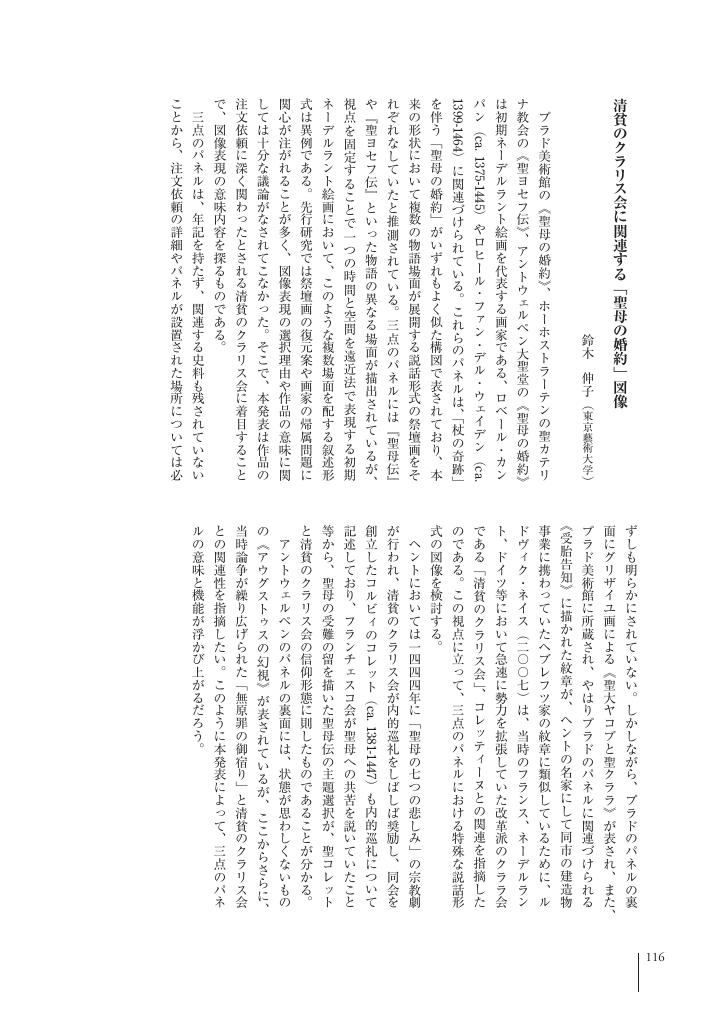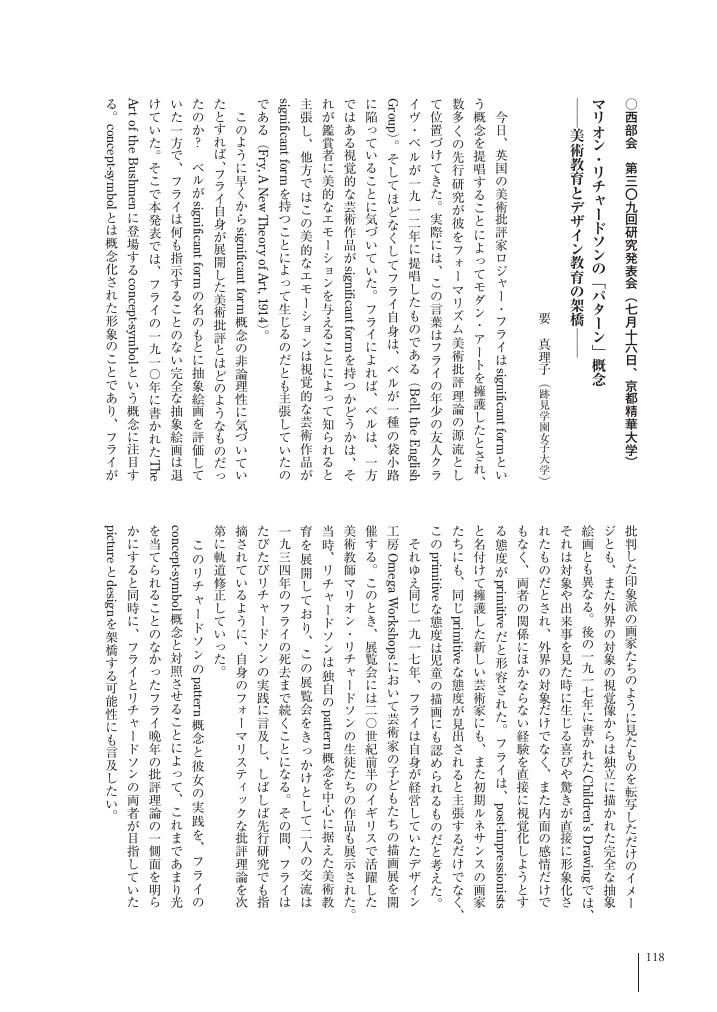1 0 0 0 OA 「キリスト教の悲劇」としての《ミサ・ソレムニス》 ルートヴィヒ・ノールのベートーヴェン論
- 著者
- 清水 康宏
- 出版者
- 美学会
- 雑誌
- 美学 (ISSN:05200962)
- 巻号頁・発行日
- vol.68, no.1, pp.139, 2017 (Released:2018-07-01)
1 0 0 0 OA ブラームス作品に見られる音程カノンの配列原理
- 著者
- 三島 理
- 出版者
- 美学会
- 雑誌
- 美学 (ISSN:05200962)
- 巻号頁・発行日
- vol.68, no.1, pp.140, 2017 (Released:2018-07-01)
- 著者
- 山田 隆行
- 出版者
- 美学会
- 雑誌
- 美学 (ISSN:05200962)
- 巻号頁・発行日
- vol.68, no.1, pp.141, 2017 (Released:2018-07-01)
1 0 0 0 OA 「花」に寄せられた自然観の独自性 未生流の華道理論を中心に
- 著者
- 東口 豊
- 出版者
- 美学会
- 雑誌
- 美学 (ISSN:05200962)
- 巻号頁・発行日
- vol.68, no.1, pp.142, 2017 (Released:2018-07-01)
- 著者
- 喜多村 明里
- 出版者
- 美学会
- 雑誌
- 美学 (ISSN:05200962)
- 巻号頁・発行日
- vol.68, no.1, pp.143, 2017 (Released:2018-07-01)
1 0 0 0 OA 「JAPAN牛窓国際芸術祭」考 八〇年代、野外美術展の変質と「美術」制度
- 著者
- 山下 晃平
- 出版者
- 美学会
- 雑誌
- 美学 (ISSN:05200962)
- 巻号頁・発行日
- vol.68, no.1, pp.73-84, 2017 (Released:2018-07-01)
This paper explores the Japan Ushimado International Art Festival held in Okayama Prefecture, Ushimado, every year from 1984 to 1992. Few papers have focused on the Japan Ushimado International Art Festival; moreover, art historians have not comprehensively explored this festival. Therefore, I clarify this festival as a whole through materials collected and interviews of the concerned people. I also examine this art historical condition. Furthermore, I consider the transformation and context of open-air art exhibitions in the 1980s Japan. Analyzing the content every time, we can determine the response to the problem of the transformation of “art work” and “display,” the dilemma of traditional large-scale art exhibitions in central Tokyo, finding that Japanese warehouses (Kura) as well as hills and harbors were being transformed into spaces for this exhibition. On the other hand, this festival references Ushimado’s local culture. Thus, the transformation of “art exhibition” such as the Japan Ushimado International Art Festival reflects not only the expansion of “art” but also the problem of the institution of “art.” This perspective indicates the aspect of post-modern Japan that cannot be overlooked.
1 0 0 0 OA アドルフ・ロースの商業建築 都市空間へのアプローチを中心に
- 著者
- 岸本 督司
- 出版者
- 美学会
- 雑誌
- 美学 (ISSN:05200962)
- 巻号頁・発行日
- vol.68, no.1, pp.97-108, 2017 (Released:2018-07-01)
Dieser Aufsatz behandelt die vom Architekt Adolf Loos während der Jahrhundertwende in Wien entworfenen Geschäftsgebäude. Bei den Häuser von Loos hat die geputzte Fassade den Effekt der schweigsamen Maske, die die Bewohner vor dem Lärm der modernen Großstadt schützt. Im Gegensatz zur dieser Maske wirken die Fassaden der Geschäftsgebäude vielmehr auf die Strasse und Platz, zu den sie hinausgehen. Dieser Aufsatz versucht zu beschreiben, wie die Wirkungen von drei Werken, das heißt dem Café Museum (1899), der Kärntner Bar (1909) und dem Looshaus (1911), verwirklicht wurde. Zunächst betrachten wir beim Café Museum die Effekte, die durch Material und Form den Fluß zwischen Räumen der Lokale und Strasse verstärkt. Dieser Fluß stimmt der Ornamentlosigkeit dieser Lokale zu. Im zweiten Beispiel hat die Kärntner Bar, eine der ersten amerikanischen Bars in Wien, auf ihrer Fassade ein Sternenbanner und eine darunter liegende Kolonnade. Diese Fassade repräsentiert die Verbindung der europäischen Tradition mit der von Amerika. Das Looshaus schließlich hat in seinem Wohnungsteil eine weiß geputzte und ornamentlose Fassade, die vom Wiener Publikum als Majestätbeleidigung der Hofburg gesehen wurde. Durch diesen Werk gelang es Loos den Stadtbewohner die architektonische und kulturelle Tradition der dieser grossen Stadt aufzuzeigen.
1 0 0 0 OA 映像作家飯村隆彦のエキスパンデッド・シネマ(拡張映画) ハプニングとの関係から
- 著者
- 望月 由衣
- 出版者
- 美学会
- 雑誌
- 美学 (ISSN:05200962)
- 巻号頁・発行日
- vol.68, no.1, pp.134, 2017 (Released:2018-07-01)
1 0 0 0 OA 宝塚少女歌劇 第一回欧州公演をめぐって イタリアにおける受容を中心に
- 著者
- 衣笠 弥生
- 出版者
- 美学会
- 雑誌
- 美学 (ISSN:05200962)
- 巻号頁・発行日
- vol.68, no.1, pp.135, 2017 (Released:2018-07-01)
1 0 0 0 OA カントにおける産出的「連想」
- 著者
- 山口 遥子
- 出版者
- 美学会
- 雑誌
- 美学 (ISSN:05200962)
- 巻号頁・発行日
- vol.68, no.1, pp.136, 2017 (Released:2018-07-01)
- 著者
- 筧 菜奈子
- 出版者
- 美学会
- 雑誌
- 美学 (ISSN:05200962)
- 巻号頁・発行日
- vol.67, no.2, pp.124, 2016 (Released:2018-01-01)
1 0 0 0 OA ヘーゲルの芸術哲学における文化「翻訳」的思索 ゲーテ『西東詩集』受容の再考
- 著者
- 髙藤 大樹
- 出版者
- 美学会
- 雑誌
- 美学 (ISSN:05200962)
- 巻号頁・発行日
- vol.67, no.2, pp.125, 2016 (Released:2018-01-01)
1 0 0 0 OA 趣味判断が誤るとき 『判断力批判』における情感的意識の観点から
- 著者
- 高木 駿
- 出版者
- 美学会
- 雑誌
- 美学 (ISSN:05200962)
- 巻号頁・発行日
- vol.68, no.1, pp.13, 2017 (Released:2018-07-01)
In the First Book of the Critique of the Power of Judgment (1790), judgments of taste which state the beauty are based on a subjctive ground, or the feeling of pleasure, so that they are not logical cognitive judgments which constitute “a cognition of the object through concepts of it” (V 211) but aesthetic judgments. Therefore, they cannot state truth or falsehood of themselves as logical cognitive judgments do. However, Kant uses the expression of “a false (or an erroneous) judgment of taste (ein irriges Geschmacksurteil)” (V 216). If this “false (or erroneous)” is not logical one, what does it mean? About what are judgments of taste false? Now, we have three leading interpretations of judgments of taste to resolve these questions, i.e. interpretation from an epistemological, moral, aesthetic point of view. But I think that the first two interpretations are not successful, because they contradict Kant’s statements in some points as I will show. Thus, in this paper by adopting the aesthetic interpretation of judgments of taste I shall answer the questions concerned, namely argue that the falsehood (or error) of them consists in choosing an inappropriate feeling of pleasure for the ground of judgments of taste.
1 0 0 0 OA 二次元的人間の予知夢 アドルフ・ヒルデブラント
- 著者
- 金田 千秋
- 出版者
- 美学会
- 雑誌
- 美学 (ISSN:05200962)
- 巻号頁・発行日
- vol.68, no.1, pp.25-36, 2017 (Released:2018-07-01)
I would like to nominate the thoughts of Hermann von Helmholtz, a celebrated German physiologist and mathematician in the nineteenth century, as a framework for interpreting sculptor Adolf Hildebrand’s great work, ‘Das Problem der Form in der bildenden Kunst’ (1893). It can be clearly inferred from Hildebrand’s letters that he had inspected Helmholtz’s popular papar on the non-Euclidean geometry system. The concept of the “plane” in this paper was decisive. Helmholtz’s thinking experiment, “Can an insect with only plane perception crawling on an egg recognize its three-dimensional curved surface?”, probably influenced Hildebrand’s sculpture-aesthetics, which analyzed the shapes of objects with a series of concepts, “face”, “layer”, “face layer”, etc. Helmholtz’s insight that “The world is made of flat surfaces” had thus profoundly affected the sculptor. What kinds of human abilities are needed to perceive the composition of the world? At the end of the eighteenth century, a controversy broke out between Immanuel Kant and the followers of Gottfried Leibniz about whether to lay the foundation of space on “intuition” or “intuition and concept”. However, Hildebrand’s involvement in this history made him confront the conflict between “intuition” and “intuition and concept”, which unexpectedly led to a serious political and racial problem.
1 0 0 0 OA ジョルジュ・バタイユのエロティスム論におけるイメージのはたらき 『エロスの涙』をめぐって
- 著者
- 井岡 詩子
- 出版者
- 美学会
- 雑誌
- 美学 (ISSN:05200962)
- 巻号頁・発行日
- vol.68, no.1, pp.37-48, 2017 (Released:2018-07-01)
L’objectif de l’article consiste à mettre en lumière une fonction des images utilisées par Georges Bataille dans ses essais sur l’érotisme, fonction différente de celle de l’image «informe» trouvée dans la revue Documents. Les Larmes d’Éros est chargé d’ouvrir la conscience à l’identité entre la «petite mort» et la mort définitive et de l’ouvrir à la conscience de soi. L’image érotique servit à leur accomplissement. Il exige de les regarder à travers les «larmes», de les prendre dans sa propre conscience. Selon Bataille, cette prise permet de produire les images érotiques mêmes : celles-ci résultent de la prise de conscience d’une violence ou d’une fièvre de l’érotisme. Ainsi, une telle image peut servir de guide pour ouvrir à la conscience de soi. À la différence de l’image «informe», forme échappant à la fixité, l’image érotique est immobile au sens où elle est une forme faite par soin, claire et déterminée. C’est grâce à ce caractère qu’elle est mise en oeuvre dans les ouvrages de Bataille, notamment d’après-guerre, pour développer la conscience humaine.
- 著者
- 筧 菜奈子
- 出版者
- 美学会
- 雑誌
- 美学 (ISSN:05200962)
- 巻号頁・発行日
- vol.68, no.1, pp.49-60, 2017 (Released:2018-07-01)
This paper analyzes the photographs and films which recorded the creation of Jackson Pollock’s all-over paintings. Hans Namuth was photographer and filmmaker who did them in 1950. There are black-white photographs which show two all-over paintings, and films which show three all-over paintings. Pepe Kermel analyzed these photographs and films, and insisted that there were humanoid and animal figures in all-over paintings (Pepe Kermel, 1998). However, as Kent Minturn pointed out (Kent Minturn, 2001), there is a possibility that Kermel arbitrarily made such figures by graphic software. This paper tries to analyze these photographs and films again. I sorted these by stages, and reconstructed whole canvas. As a result, it became clear that there are humanoid figures and materials at the first layers of No. 27, 1950, No. 29, 1950. Pollock drew strokes on upper layers to cover these figures. Meanwhile, on the red canvas picture which is lost now, Pollock didn’t draw the representational figures, but made each layer by repeating same simple lines from side to side. We can see that Pollock had two methods for making all-over paintings, one with representational figures and one without.
1 0 0 0 OA 清貧のクラリス会に関連する「聖母の婚約」図像
- 著者
- 鈴木 伸子
- 出版者
- 美学会
- 雑誌
- 美学 (ISSN:05200962)
- 巻号頁・発行日
- vol.67, no.2, pp.116, 2016 (Released:2018-01-01)
1 0 0 0 OA 「触常者」の美学仮説 ユニバーサル・ミュージアムの理論のために
- 著者
- 篠原 聰
- 出版者
- 美学会
- 雑誌
- 美学 (ISSN:05200962)
- 巻号頁・発行日
- vol.67, no.2, pp.117, 2016 (Released:2018-01-01)
1 0 0 0 OA マリオン・リチャードソンの「パターン」概念 美術教育とデザイン教育の架橋
- 著者
- 要 真理子
- 出版者
- 美学会
- 雑誌
- 美学 (ISSN:05200962)
- 巻号頁・発行日
- vol.67, no.2, pp.118, 2016 (Released:2018-01-01)
1 0 0 0 OA ピランデッロと初期映画
- 著者
- 岡田 温司
- 出版者
- 美学会
- 雑誌
- 美学 (ISSN:05200962)
- 巻号頁・発行日
- vol.67, no.2, pp.119, 2016 (Released:2018-01-01)













